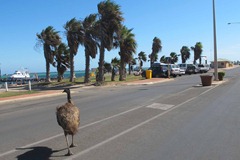 We stayed at Denham a small fishing village in the Shark Bay World Heritage Area. Photos cannot do justice to the beauty of this region or its diversity.
We stayed at Denham a small fishing village in the Shark Bay World Heritage Area. Photos cannot do justice to the beauty of this region or its diversity.
We visited the Heritage centre in Denham which outlines the reasons for this being a World Heritage Area.
As the photo shows, even emus enjoy a beach holiday.
We were about 20 kilometers from Monkey Mia where the dolphins come to be fed. Tricia was lucky enough to be chosen to give fish to one of the dolphins.
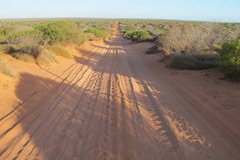
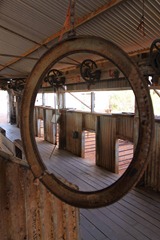
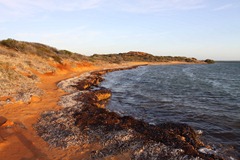
In the afternoon we went for a drive in the Francois Peron National Park, exploring the shearing shed and tracks to Peron Point and the Big Lagoon.
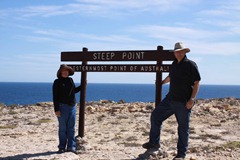
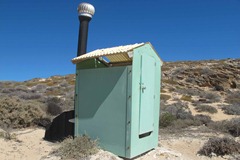
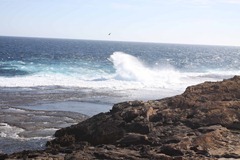
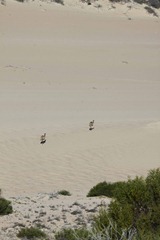
The next day we drove 500 kilometer round trip, much of it 4WD only, to the most Westerly Point of Australia at Steep Point. Steep Point is very satisfactory. As the name suggests it is steep and pointy and gives a good view of Dirk Hartog Island, where Dirk Hartog landed in 1616, preceded by Willem Janzoon but predating Australia’s “discoverer” Captain Cook by 162 years. We signed the visitors book. You can camp there, use Australia’s most westerly toilet, and enjoy the fact that you are as far from Canberra as you can get on the mainland.
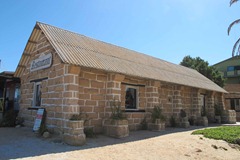 We also visited the Blowhole further down the coast. On the drive back we saw more Emus, this time not on the main road.
We also visited the Blowhole further down the coast. On the drive back we saw more Emus, this time not on the main road.
That evening dinner was at the Old Pearler Restaurant. It is built of Coquina shells which have aggregated sufficiently to be carved into solid blocks so that walls can be built of them. Acoustics are very good, owing to all the air spaces in the shells and the room also maintains an even temperature. The food and service is good. It is the most Westerly Restaurant in the State, probably because it was built before planning permits and so didn't need to be set back.
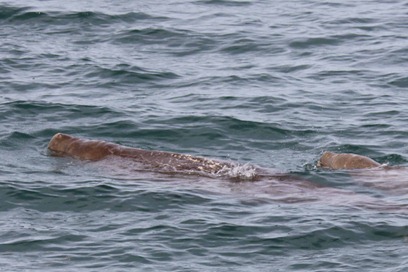
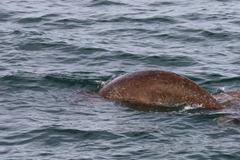
The next day we sailed on the Shotover Catamaran to see some of the marine life in the bay. We were lucky enough to see two dugongs, a mother and baby. Dugong’s are rather like sea cows, grazing on the sea grass beds and coming to the surface every three or four minutes to breath and then diving back down with gracefully arched backs. With their wide snouts it is hard to imagine ancient mariners mistaking them for mermaids.
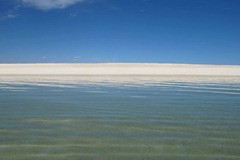
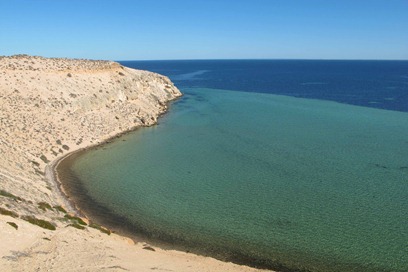
We visited Shell Beach which is comprised almost entirely of shells. At nearby Eagle Bluff you could stand there all day with an Eagle’s eye of the sea, watching the marine life. We saw several sharks and some stingrays.
Yet another lookout provided another shelly beach.
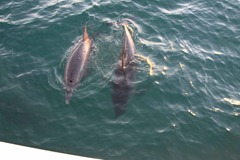
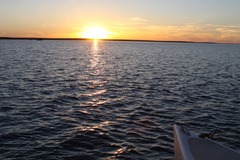
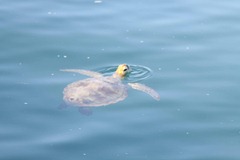
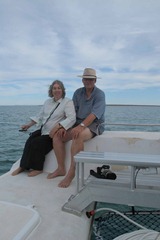 A sunset cruise on the Shotover gave us a view of dolphins at play and a loggerhead turtle, finishing up a very satisfactory week with dinner at the Bough Shed.
A sunset cruise on the Shotover gave us a view of dolphins at play and a loggerhead turtle, finishing up a very satisfactory week with dinner at the Bough Shed.
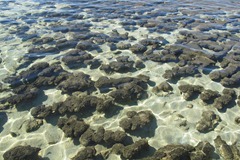 On the way out of Shark Bay we stopped at Hamelin Pool and saw the Stromatolites. Built by cyanobacteria, the world’s oldest single cell organisms, hugely efficient oxygen producers and critical to the earth we have today, they are however not very interactive. We also saw the historic shell quarry, only used to repair buildings nowadays.
On the way out of Shark Bay we stopped at Hamelin Pool and saw the Stromatolites. Built by cyanobacteria, the world’s oldest single cell organisms, hugely efficient oxygen producers and critical to the earth we have today, they are however not very interactive. We also saw the historic shell quarry, only used to repair buildings nowadays.

 We stayed at the Wintersun Caravan Park in Carnarvon.
We stayed at the Wintersun Caravan Park in Carnarvon. 
 We visited Carnarvon’s Historic District and walked out on the 1 mile jetty, the longest jetty in north west Western Australia. This jetty was used to take produce to market and for shipment of sheep. Now it is a great walk and fishing spot. We saw two dugong grazing on the sea grass
We visited Carnarvon’s Historic District and walked out on the 1 mile jetty, the longest jetty in north west Western Australia. This jetty was used to take produce to market and for shipment of sheep. Now it is a great walk and fishing spot. We saw two dugong grazing on the sea grass 




























 Geraldton is on the coast with the Chapman and Greenough Rivers to the north and south. It claims the highest lighthouse in WA.
Geraldton is on the coast with the Chapman and Greenough Rivers to the north and south. It claims the highest lighthouse in WA.




































![NEW - THE MAPS [By Popular Request]](http://1.bp.blogspot.com/-Vajyd8kXoSk/TtvtX94QV7I/AAAAAAAAEBk/0MJEoH3UojI/s187/Around%2BAustralia.jpg)